Table of Contents
Considering that we are the Toronto Marine Historical Society and that one of the main purposes of our publication is to present material concerning vessels and fleets that may have escaped the attention of other marine journals, it is not surprising that, over the years, we have featured many of the major Lake Ontario passenger steamers which operated out of Toronto, as well as some of the boats which ran the many ferry routes around the harbour.
In this respect, we have featured, at various times, JOHN HANLAN, KATHLEEN, ISLAND QUEEN, JASMINE, LUELLA, T. J. CLARK and the big double-ended paddlers MAYFLOWER and PRIMROSE. In fact, of all the famous ferries which ran to the Toronto Islands for any length of time during the late "teens" or the 1920s, only three have not been the subject of feature articles in "Scanner". TRILLIUM is one, and that is because she is still running. BLUEBELL, her near-sister, is the second, because not very much can be said about her long and relatively uneventful career. The third is CLARK BROS., and the reason we have not featured her is that, until now, there have been far too many unanswered questions concerning her four-decade lifetime.
But unearthing the answers to old questions is one of our great joys, and having now discovered as much about CLARK BROS. as we are ever likely to do, it seems timely that we should feature her story here and present some of the excellent photographs that remain to remind us of this hard-working little steamer. Of course, as we shall see, there still are more questions to be answered, but they are of such a nature that we hold out very little hope of ever discovering the necessary information.
CLARK BROS. (and yes, her name was officially registered in this abbreviated form) was enrolled as C.94984 at Toronto in February of 1890. She was built during the winter of 1889-1890 at Toronto by D. W. Murphy and Medlar & Arnot, no doubt at the latter firm's shipyard which was located toward the eastern end of the Toronto waterfront. It seems likely that Murphy was the master builder employed by Medlar & Arnot.
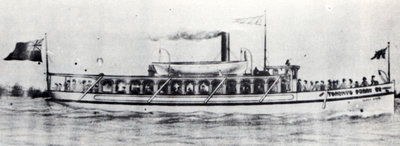
A 1904 drawing by Charles Gibbons shows CLARK BROS. only three years after her rebuilding as a passenger ferry.
The steamer was built to the order of the Clark family of Toronto, which later was to operate the steamers ELSIE (1906) and T. J. CLARK (1911), and which at one time was incorporated as Clark Limited. (T. J. CLARK, a composite-hulled steamer, actually was built on the Clark property at the foot of Yonge Street, Toronto.) One of the Clark brothers was T. J. Clark, who was always called "Tom" by his wife. The 1895 Dominion List of Shipping showed the registered owner of CLARK BROS. to be Joseph Clark, and we suppose that he was another brother, although the possibility exists that Joseph may simply have been Tom's middle name. In later years, after Tom died, the company was run by his widow, Margaret A. Clark, who adopted a "hands-on" approach to the freight business, and who had no compunction at all about handling freight with the rest of the crew, or crawling inside her steamer's boiler to attend to maintenance.
Over the years, the Clarks were to become prominent on Toronto Bay in the business of carrying freight to and from the Toronto Islands. By the time of the construction of CLARK BROS., a considerable summer community had developed on the Islands, particularly on Hanlan's Point, where also was located a large amusement park. Not only were victuals and other supplies to be moved across, but the belongings of the residents had to be ferried back and forth each spring and fall, for the best-known members of Toronto's social community spent their summers in their beautiful Victorian cottages at the beach, far from the heat and crowds of the summer city streets.
CLARK BROS. was an oak-hulled, single-deck, freight steamer, 40.0 feet in length, 8.9 feet in the beam and 3.4 feet in depth, with tonnage of 5 Gross and 3 Net. A propellor, she was powered by a high-pressure, non-condensing steam engine, with one cylinder of 9 inches diameter, and a stroke of 9 inches. The indicated horsepower was 125 and the engine could turn 160 revolutions per minute. Steam at 100 p.s.i. was produced by one firebox boiler, which measured 4 feet by 7 feet and had but one coal-fired furnace. Both engine and boiler were built by H. W. Petrie at Toronto, but the 1899 Great Lakes Register indicated that neither was built until 1892. We suspect that this may be a misprint, perpetuated over the years in various publications, since it is unlikely that the steamer's hull lay for two years before the machinery was installed, and even more improbable that she was given all new machinery when she was only two years old.
One undocumented report has stated that CLARK BROS. was powered by a steeple compound engine, built by the Doty Engine Works, Goderich, but this seems to bear no relation to what is known of the ship herself. Persons still living who recall riding aboard CLARK BROS. in her later years do not recall steeple compound machinery, and the engine was completely open to the view of any passengers riding in the main deck cabin.
CLARK BROS. was built for freight-only service, and there is no indication anywhere that she carried passengers at any stage during the early years of her career. We do not have any likeness of the steamer in those early times, and so we can hazard no guess as to her appearance in the 1890s. It would seem, however, that CLARK BROS. was not large enough for the business which the Clarks developed, for Supplement No. 1 to John Mills' Canadian Coastal and Inland Steam Vessels, 1809-1930 indicates that CLARK BROS. was rebuilt in 1896, being enlarged to 51.0 feet in length, 11.0 feet in the beam, and 33 Gross Tons. Although it is not specified where this work was done (perhaps at the Medlar & Arnot yard?), the fact that the steamer actually was rebuilt would appear to be verified by the re-registering of CLARK BROS., as recorded by the local registrar at Toronto in April 1896.
It seems evident that CLARK BROS., enlarged as she was, continued in the Island freight trade, still running for the Clark family. Again, however, we have no identifiable photograph or drawing of her at this stage of her career, so we cannot comment upon her appearance, although there is no reason to imagine that she was anything more than a longer and beamier version of the single-decker as which she was built.
While the Clarks were finding success with their harbour freight business, passenger traffic to the Islands was booming and several companies were running ferry routes from assorted city docks to various points on the Islands. As early as 1887, efforts had been made to consolidate the ferry services, and Toronto City Council had laid down rules to apply, in the best interests of the public, to a possible future ferry monopoly. Nothing transpired for several years, although the Doty Ferry Company (operated by John and F. W. Doty) emerged as the principal operator of ferryboats on the bay.
According to The History of the Water Front of the City from 1669 to 1912, by V. M. Roberts, it was oh November 5, 1889 that a stock company was formed by E. B. Osier, William Hendrie, F. W. Doty and Henry Beatty. According to the newspaper "The Globe" and Robertson's Landmarks of Toronto, it was on February 27, 1890 that these gentlemen registered the Toronto Ferry Company Limited as a joint stock company, capitalized at $250,000. They completed the acquisition of the Doty Ferry Company's fleet of steamers, and on April 2, 1892, the new company (which already had commissioned its newly-built double-enders MAYFLOWER and PRIMROSE) acquired the boats previously operated by A. J. Tymon's Island Park Ferry Company.
In 1893, Osler was president of the Toronto Ferry Company, Hendrie was vice-president, R. A. Smith was secretary and treasurer, and W. A. Easson was manager. By 1905, the capital stock had been increased to $600,000 and, that year, H. S. Osier, Britton Osier, William B. Raymond, D'Alton McCarthy and Frank Ford were elected to the board of directors. R. A. Smith was still on the board in 1906. By the turn of the century, the company's manager was Lawrence J. Solman, who eventually acquired complete control of the firm.
Under Solman's guidance, the company flourished and even controlled the big amusement park at Hanlan's Point. The firm ran several services to the Islands with departures at various times from Yonge, Bay, Church, Brock and Dufferin Streets. In the early years, the most popular destination was Hanlan's Point, but boats also operated to Island Park (the picnic area situated on Meade's Island, connected by bridge to Centre Island where there were hotels and many large summer residences). Ferry service was also provided to Ward's Island, where the Wiman Baths were located, and where a summer tent community had begun to establish itself.
Just before the end of the old century, with business booming, the Toronto Ferry Company sought additional passenger capacity and cast its eyes in the direction of the little CLARK BROS. An arrangement appears to have been made between the company and the Clarks, for in 1901, CLARK BROS. was completely rebuilt. She emerged with a length of 80.0 feet, a beam of 16.2 feet and a depth of 5.5 feet, with tonnage of 92 Gross and 38 Net. Because of the major alterations, she was re-registered at Toronto on June 13, 1901. Her owner was shown as "Mary" (more properly Margaret A.) Clark, and there was a mortgage of $5,045 to Toronto shipyard operators Medlar & Arnot. It is unlikely that this mortgage had anything to do with the 1901 rebuild, and it is more probable that it related either to the original construction of CLARK BROS. or to her rebuild of 1896.
The answer appears to lie in another note from V. M. Roberts who, in an item dated Friday, April 25, 1902, stated that the Toronto Ferry Company's new boat was named LILY, and had been towed from Oakville for completion at Hanlan's Point. There followed, in brackets, the name "KATHLEEN". It is a virtual certainty that Roberts actually was referring to CLARK BROS., for it would have been natural for the T.F.Co. to consider renaming her even if it never did re-register her as LILY. The Roberts item would also confirm what we have long believed to be the case, and that is that CLARK BROS. was rebuilt at the Andrews shipyard at Oakville. Why the mention of KATHLEEN (our Ship of the Month No. 155), when she was not rebuilt at that time and, as far as we know, nobody ever considered changing her famous name? We believe that Roberts intended the reader to understand that it was KATHLEEN that towed the other ferry from Oakville to Toronto, just as KATHLEEN towed the rebuilt ISLAND QUEEN from Bronte back to Toronto in 1905.
However, even though the Toronto Ferry Company was running CLARK BROS., Mrs. Clark still owned her. According to the local registrar's books, assignment of the mortgage interest of Medlar & Arnot was made to Lawrence Solman on August 21, 1902. It was not until August 28, 1906, that there finally was a bill of sale of CLARK BROS. from "Mary" Clark to Lawrence Solman, and thereafter CLARK BROS. remained registered in his name for the two further decades in which she operated for the Toronto Ferry Company.
Some sources have thought that it was in the 1901 rebuild that CLARK BROS. was made over into a double-decker, but this was not the case. A 1904 drawing of the steamer by the famous Toronto harbour artist Charles I. Gibbons (noted for his attention to accuracy of detail) shows a handsome, single-decked steamer, with the Ferry Company's name on her rail. She had an open foredeck, a long cabin with arch-topped windows, and a small open area aft. A small pilothouse, with a three-sided front and large windows, was placed at the forward end of the cabin. A short mast rose just abaft the pilothouse and a fairly short and thin stack was set not far back of the mast. Passengers were not allowed on the cabin roof, but the steamer's one large lifeboat was placed there, worked from radial davits.
By about 1910, however, as evidenced by readily datable photographs, CLARK BROS. had been rebuilt as a double-decker, with an upper deck that ran the full length of the ship, surrounded by distinctive, heavy, wooden-slat bull-rails, and with benches for the passengers. The pilothouse was moved to the upper deck, and a shade deck was built over the after section of the promenade. There still was only one lifeboat, set on the starboard side of the new hurricane deck. The forward section of the main deck, although covered, was open at the sides, and there were wooden floats there for the passengers to use as seats. There were two gangways on each side, one at the after end of the open foredeck, and one part-way back through the cabin.
Inside the forward section of the closed cabin was located the boiler, housed out of passenger sight. Abaft the boiler was the open engine area, with the cylinder head and controls visible to the passengers, the engineer being positioned just below and slightly forward of the stairs that led to the upper deck. A row of bench-seats ran down each side of this part of the cabin, facing inboard. In the aft part of the cabin, back of the second gangway, benches again ran down each side, while a double-sided, high-backed seat was set between them. This same general cabin configuration was also to be found in the company's steamers ISLAND QUEEN, KATHLEEN and JOHN HANLAN.
The 1910s were successful and uneventful years for CLARK BROS., and about the only change in this period was the addition of a second lifeboat on the hurricane deck, a legacy of the loss of the White Star liner TITANIC, which stimulated public concern over the capacity of the lifeboats carried even on harbour ferries. In the government inspection reports of 1915 and 1916, it was stated that CLARK BROS. was licenced to carry 216 passengers. There has been some suggestion that CLARK BROS. was damaged in the March 12, 1918 fire which destroyed ISLAND QUEEN and KATHLEEN in winter quarters at the Hanlan's Point docks, but we can find no evidence that this was so, and in fact we cannot even verify that CLARK BROS. was anywhere near the two burning boats. Contemporary press reports mentioned minor damage to certain other ferries, but CLARK BROS. was not mentioned at all.
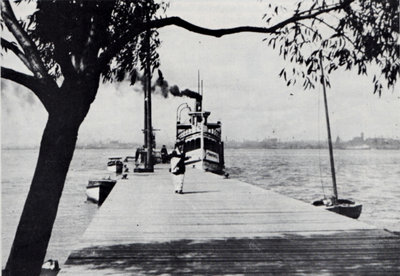
It was the summer fo 1913 when the camera of Rowley W. Murphy caught CLARK BROS. at the old Ward's Island pier.
However, few and far between were the wooden steamers which did not suffer fire damage at some stage of their lives, and CLARK BROS. got hers on Thursday, April 21, 1921, at which time, according to the Wreck Commissioner's report, she was commanded by Capt. Nelson W. Miner. (See references to this longtime ferry skipper in connection with ISLAND QUEEN and KATHLEEN.) There follows the report contained in "The Globe" of April 22nd, 1921.
"The heavens were aglow and the various craft at anchor in the Bay were silhouetted in weird, fantastic forms when the ferry boat CLARK BROS., owned by the Toronto Ferry Company, burned down to the water line last night at 8 o'clock. The damage was said to be in the neighbourhood of $6,000 which is covered by blanket insurance with Lloyd's. The firemen, who reached the blazing boat in record time, had the fire under control within twenty minutes. While it lasted, however, the fire was nothing short of spectacular. The ropes which held the CLARK BROS. to her moorings burned up, and she went adrift, probably through the force of the streams of water which were pouring into her from the shore. As the boat was tied closely to the wharf, the flames which shot upward from her burning decks and hold licked the roof of the wharf building. As there was no wind, however, the fire did not spread. The CLARK BROS. had been running all day yesterday, and came in after her final trip at 6 o'clock. The origin of the fire is unknown, although the firemen expressed the opinion that an overheated boiler had been the cause."
True, CLARK BROS. was severely damaged in the fire, but she did not burn to the waterline as "The Globe" suggested. A photograph of the burned ferry, which appeared on the front page of "The Toronto Daily Star" on April 22nd showed that her superstructure remained standing, although it had been almost completely gutted. Nevertheless, the Ferry Company sorely needed the services of CLARK BROS., and decided to repair her. It is thought that the repair work was done by the Toronto Dry Dock Company, one of the principals of which just happened to be Lawrence J. Solman!
The work was started immediately. CLARK BROS. was rebuilt generally along her earlier lines, although her superstructure woodwork was much more plain than before, and the absence of her old decorative fretwork around windows and deck edges gave her a rather stark appearance. She received wire mesh handrails, and a typical Toronto Ferry Company pilothouse, a new squarish structure with three big windows in its front and a marked overhang of the roof forming a brim. Her mast had disappeared by this time and her forward running light was a lamp set on a post atop the pilothouse roof just abaft the steamer's rather large bell. It is interesting to note that, during her rebuild, CLARK BROS. was fitted with electric lights; she was the only one of the smaller T.F.Co. boats that ever was so equipped.
The 24th of May holiday was always a busy day for the ferries, but in 1921 CLARK BROS. was not operating, for she was still in the shipyard. Accordingly, "Lol" Solman chartered the freight boat T. J. CLARK from Mrs. Clark for the day, and she was pressed into service. As she had no passenger facilities whatever, those persons who rode her to Centre Island had either to sit on one of the life floats on deck or else stand for the crossing. It was not long, however, before CLARK BROS. was back in service, once again sporting the usual T.F.Co. colours, with white hull and cabins, black stack, grey deck, and dark green trim with dark brown seats on the upper deck.
CLARK BROS. operated primarily on the Ward's Island route. She usually was the last boat running each autumn, not laying up until the ferry service was closed for the winter on December 15, while the similar but slightly smaller JOHN HANLAN usually laid up on Hallowe'en night. During the mid-1920s, CLARK BROS. had as her master the venerable Capt. Nelson Palmateer of Cherry Valley, Prince Edward County. One of Lake Ontario's most revered sailors, he founded the annual Mariners' Service which was held each spring for many years at Cherry Valley. Your T.M.H.S. secretary made many crossings of the bay riding in the pilothouse of CLARK BROS. with Capt. Palmateer.
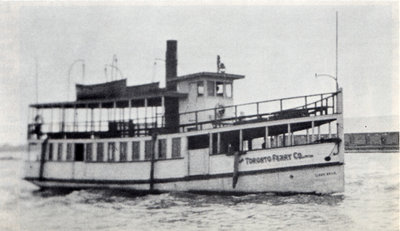
With the harbour redevelopment underway, CLARK BROS. arrives at the old Bay Street ferry docks in this photo by J. H. Bascom, c. 1923.
Each of the ferry steamers had its own individual "quirks", and one exhibited by CLARK BROS. was that she did not have enough power to back away from the old Ward's Island pier if there was a strong northwest wind from astern. Captain Palmateer's method of overcoming this problem was to come in across the end of the dock, swinging the steamer's head up toward the wind. He would then let the wind blow her back around the end of the pier so that he could moor her facing outward on the east side, and thus be able to steam straight out into the bay upon departure.
But by this time, the Toronto Ferry Company was well past its prime. The boats were falling into disrepair and there was much public outcry about the fares charged and the service provided. The City of Toronto eventually decided that the ferry service had to be taken out of the hands of private operators, and it was decreed that the Toronto Transportation Commission, which had taken over the operation of Toronto's street railways in 1921, was to be the operator of the ferries as well. The sale of the boats to the City of Toronto was negotiated during 1926, and the bill of sale of CLARK BROS. from Lawrence Solman to the City was dated November 1, 1926. During the winter, the ferry fleet was refurbished as much as possible, and the first day of T.T.C. service was April 15, 1927.
CLARK BROS. looked smart in her new colours, with a grey hull, white cabins with yellow window trim, and a black stack, even though her age was showing and her stern was beginning to sag. She remained on the Ward's Island route most of the time. One of her first skippers under T.T.C. management was Capt. William Bryan. He was not as adept at handling CLARK BROS. as had been Nelson Palmateer, and he got her caught in the wind one day whilst trying to back away from the Ward's Island dock; he put her ashore on the beach nearby, and the incident cost him his employment.
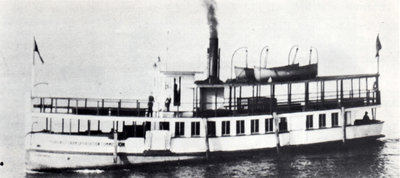
It is August 1927, and CLARK BROS. is seen from the deck of DALHOUSIE CITY in a photo by J. H. Bascom.
One of the last masters of CLARK BROS. was Capt. Patrick J. McSherry, who moved over from JOHN HANLAN, which failed her inspection in the spring of 1929. An affable gentleman who had been the keeper at Toronto's Gibraltar Point Lighthouse on the Island for many years, he also had owned the old steamer ONGIARA (I), (a) QUEEN CITY (88), from 1912 until her loss in 1918. He came from a family of Lake Ontario sailors, and his father and three of his brothers were lost in November 1880 when the schooner BELLE SHERIDAN foundered in Weller's Bay. In the days of Lawrence Solman and the Toronto Ferry Company, ferry skippers never were required to wear uniforms unless they so desired and bought them on their own. Pat McSherry took full advantage of this situation and usually could be seen sporting a bowler hat. In later years, it was with great reluctance that he complied with the T.T.C. requirement that its officers wear full uniforms, complete with peaked caps.
CLARK BROS. ran in 1927, and again in 1928 and 1929. but the steamer was in such deteriorated condition that, during the autumn of 1929, the stairs to her upper deck were kept roped off in order to prevent passengers from venturing above and keep them safe in the cabin below. Frequently it was found necessary to place barrels of sand on her main deck in order to help the old boat maintain her stability in nasty weather. At the close of the 1929 season, CLARK BROS. was condemned and she never ran again. In that same year, her former running mates JOHN HANLAN and JASMINE had been burned at Sunny-side Park, off the Western Gap, as public spectacles.
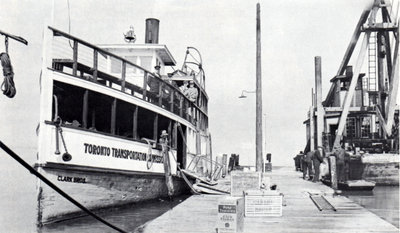
There is high water as CLARK BROS. is moored at Ward's Island in a T.T.C. photo, May 22, 1929. Captain McSherry is second from left on the upper deck.
In April of 1930. as CLARK BROS. lay in the slip at the far east side of the city ferry docks, much of her equipment was taken off and transferred to the T. J. CLARK, which earlier had been acquired by the City of Toronto, and which was fitted out as a passenger boat to replace CLARK BROS. The older steamer was then hauled away from the city docks, and was moored at Ward's Island, tucked away in the old "lifesavers' slip" to the west of the house that stood on the "government preserve" back of the inner pier of the Eastern Gap. Looking terribly decrepit by this stage, she lay there during May and June, and at least one observer who went aboard her during that period noted that on the inside of her hull timbers could still be seen the charring that had been suffered in the fire of 1921.
But the public of Toronto still had a desire for spectacles, and in yet another display of monstrous bad taste and "public vandalism", the Toronto Harbour Commission decided that CLARK BROS. should be burned at Sunnyside as a part of the Dominion Day celebrations. "The Globe" of Tuesday, July 1st, told the sad story of the evening of June 38 and the early morning hours of July 1, 1930.
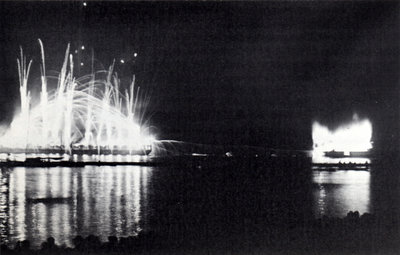
At about 1:00 a.m. on July 1, 1930, CLARK BROS. (right) burns off Sunnyside Park in a T.T.C. photo. At left is the fireworks barge.
"Twenty-five thousand dwellers in Toronto opened their Dominion Day celebrations by getting wet - very wet. The rain descended and the floods came exactly five minutes after the grand climax of the Sunnyside Beach midnight celebration of July First. There was the old Ward's Island ferry CLARK BROS. lighting the night with flame. There was the rain coming down like a million taps turned full on. There was a holiday crowd fleeing for shelter through the wet darkness of 1 a.m. And there was one night (street)car for the multitude. Not a happy beginning for Dominion Day, 1930. Yet maybe, when all is dry again, it will have been worth getting wet for.
"Along the beach for a mile, along the boardwalk, along the Boulevard Drive, the crowd began lining up at 10 o'clock last night. At half-past eleven, motorboats, canoes, and here and there a misty white sail crept up between breakwater and shore, near to the moored barges and the old white-painted ferry boat. At 12, the first rocket was to rise from the fireworks barge. At 12:30, "the crowd still waited and the first rockets had not risen. Only lightning lit the thick darkness that was sky and the shining darkness that was water - lightning and the lamps of the drifting boats.
"Suddenly, thin long green and red paths lighted across the dark ripples, rockets shot into the sky, and a mile-long 'O-o-h' lifted from beach and boardwalk. Showers and sprays of coloured fire, pinwheels, Roman candles, rockets - the glory in the sky was doubled in the moving water, and a wide fringe of lifted faces shone red and green and yellow by turns between shining water and grey sand, and more rockets went up and the colour changed again.
"At ten minutes to one, a torpedo showering silver sparks shot from the barge across to the dark hulk by the breakwater. It touched, and before a second torpedo could travel the 100 feet between barge and ferry, the CLARK BROS. had flowered in flame from bow to stern. Great fire-tinted clouds of smoke hung low and drifted shoreward; decks and rails were etched black against waves of gold and crimson. It was 'quite a sight', as a judicious onlooker was heard to remark at the moment of the old ship's final flaming beauty. Then, as has been said, it rained."
The registry of CLARK BROS. was closed on July 9th, 1930.
Ed. Note: We would not have been able to put together this history of CLARK BROS. had not J. H. Bascom shared with us his personal reminiscences of the steamer, had not the late Jim Kidd spent considerable time researching the ownership of the boat, and had not the late Alan Howard preserved many rare ferryboat photographs. Somehow, he obtained and kept photographic copies, which some unknown person took, of eight Gibbons drawings of early ferries, one of them being CLARK BROS. The copies are priceless, for none of the original drawings are known to have survived.
Previous Next
Return to Home Port or Toronto Marine Historical Society's Scanner
Reproduced for the Web with the permission of the Toronto Marine Historical Society.